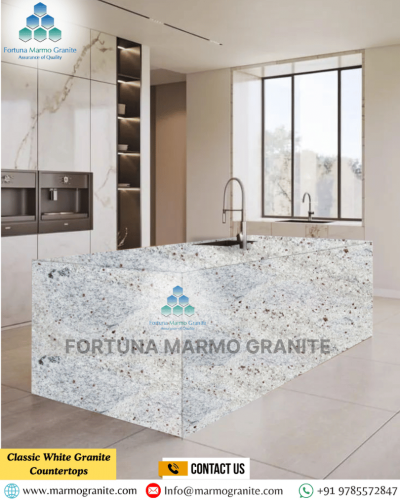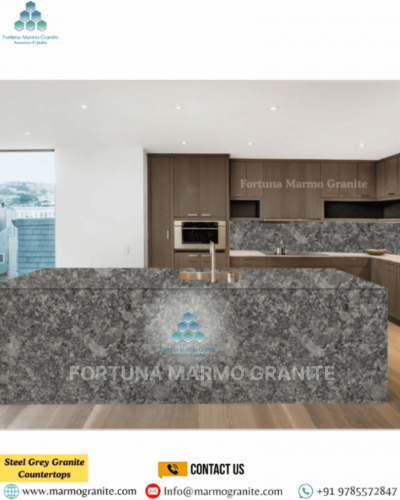How to Pick the Right Granite Countertops : Everything You Need to Know
How to Pick the Right Granite Countertops have long been admired for their luxurious appearance, robust durability, and timeless appeal, making them a sought-after choice in kitchens and bathrooms around the world. Their natural patterns, unique color variations, and resistance to heat and scratches not only enhance the visual aesthetics of a space but also provide long-term functionality that justifies the investment. However, choosing the perfect granite countertop involves more than just selecting a color that matches your cabinets. It requires an understanding of the various types of granite available, including their origin, density, and finish; knowing how to assess quality; comparing edge profiles; and factoring in practical considerations like maintenance and installation.
How to Pick the Right Granite Countertops With countless varieties—ranging from classic Absolute Black and Kashmir White to exotic options like Blue Bahia and Alaska Gold—each slab tells its own geological story, making your countertop truly one-of-a-kind. This in-depth guide aims to simplify the selection process by covering everything from the formation and properties of granite to trends, cost considerations, and expert tips on working with suppliers. Whether you're renovating your kitchen or designing a brand-new space, this resource will help you make a confident and informed decision that elevates both the beauty and value of your home.
Why Choose Granite?
Before diving into the specifics of selection, let's briefly revisit why granite is such a sought-after material for countertops:
- Durability: Granite is an incredibly hard natural stone, making it highly resistant to scratches, chips, and heat. This makes it ideal for busy kitchens.
- Beauty: Each slab of granite is unique, with its own distinct patterns, colors, and veining. This natural artistry adds a touch of elegance and sophistication to any space.
- Increased Home Value: Granite countertops are a desirable feature for homebuyers, often leading to a good return on investment if you decide to sell.
- Easy Maintenance: Once sealed, granite is relatively easy to clean and maintain, requiring only regular wiping with a mild cleaner.
- Hygienic: The non-porous surface, when properly sealed, resists bacterial growth, making it a sanitary choice for food preparation areas.
Understanding Granite Basics: What You Need to Know Before You Shop
- Granite vs. Other Natural Stones:
While often used interchangeably by some, "granite" is a specific type of igneous rock. It's important to differentiate it from other natural stones like marble, quartz (engineered stone), or soapstone. While all have their merits, granite offers a unique combination of hardness, heat resistance, and aesthetic variety.
- Natural Variation is Key:
No two slabs of granite are exactly alike. This is one of its greatest appeals, but also something to be aware of. The sample you see in a showroom might vary slightly from the actual slab you purchase. It's always recommended to view the full slabs before making a final decision.
Factors to Consider When Choosing Your Granite
Color and Pattern: Harmonizing with Your Aesthetic
This is often the first consideration for homeowners. Granite comes in a vast array of colors, from classic blacks and whites to earthy browns, vibrant blues, and even striking reds. The pattern can range from subtle speckles to bold, dramatic veining.
- Consider your existing décor: Do you want the countertops to blend in or be a striking focal point?
- Cabinetry: Dark granite can create a dramatic contrast with light cabinets, while light granite can brighten up a space with dark cabinets. For a cohesive look, consider granite with undertones that complement your cabinet finish.
- Flooring and Wall Color: Take samples of your flooring and paint colors with you when shopping for granite to ensure a harmonious overall scheme.
- Lighting: Natural and artificial lighting can drastically alter the appearance of granite. View samples in different lighting conditions if possible.
- Desired Mood: Do you want a warm, inviting feel, a sleek modern look, or a rustic charm? The color and pattern of your granite will play a significant role in setting the mood of your space.
Finish: Polished, Honed, or Leathered?
The finish refers to the surface treatment of the granite, which affects its look, feel, and maintenance.
- Polished (High-Gloss): This is the most common finish. It creates a highly reflective, shiny surface that enhances the stone's colors and patterns. Polished granite is generally the easiest to clean and is highly stain-resistant when sealed.
- Honed (Matte): A honed finish creates a soft, non-reflective matte surface. It gives a more natural, understated look. Honed granite can show fingerprints and oils more readily and may require more frequent sealing as its pores are more exposed. However, it's also less prone to showing etching from acidic spills.
- Leathered (Textured): This finish has a slightly textured, soft sheen, resembling the feel of leather. It's achieved through a brushing process that leaves the surface with subtle highs and lows. Leathered granite offers a unique, tactile experience and is good at hiding smudges and fingerprints. It also tends to be less prone to showing etching than polished finishes.
Edge Profile: The Finishing Touch
The edge profile defines the shape of the granite's exposed edge. This seemingly small detail can significantly impact the overall look and feel of your countertops.
- Standard (Eased or Straight): A simple, slightly rounded edge that provides a clean, modern look. This is often the most cost-effective option.
- Bullnose (Full or Half): A completely rounded edge that gives a soft, classic appearance. Full bullnose edges are easy to clean, while half bullnose offers a softer look with a flatter underside.
- Bevel: A 45-degree angled cut on the top edge, creating a sleek and architectural look.
- Ogee: A more decorative, S-shaped curve that adds an elegant and traditional touch. This is often a more expensive option due to the intricate fabrication.
- Waterfall: The granite extends vertically down the side of a cabinet or island, creating a dramatic, seamless look.
Slab Thickness: Standard vs. Designer
Granite countertops typically come in two standard thicknesses:
- 2 cm (approx. 3/4 inch): This is a lighter and often more affordable option. It usually requires a plywood underlayment for support.
- 3 cm (approx. 1 1/4 inch): This is the more common and preferred thickness, offering greater durability and a more substantial look. It often doesn't require a plywood underlayment.
While 2 cm can work, 3 cm is generally recommended for its strength and aesthetic appeal.
Maintaining Your Granite Countertops
Once installed, proper maintenance will ensure your granite countertops last for decades.
- Daily Cleaning: Wipe down with a soft cloth and a mild soap-free cleaner or a stone-specific cleaner. Avoid harsh chemicals, abrasive cleaners, or scouring pads, as these can strip the sealant or scratch the surface.
- Prompt Spill Cleanup: Immediately wipe up spills, especially acidic liquids like lemon juice, wine, or vinegar, to prevent etching or staining.
- Re-sealing: Re-seal your granite every 1-3 years (or as recommended by your fabricator) using a high-quality granite sealer. A simple water test can indicate if re-sealing is needed: if water beads on the surface, the sealant is still effective; if it soaks in, it's time to re-seal.
- Use Trivets and Hot Pads: While granite is heat-resistant, prolonged exposure to extreme heat can potentially cause thermal shock or affect the sealant. Always use trivets under hot pots and pans.
- Use Cutting Boards: Although granite is scratch-resistant, it's not entirely scratch-proof, and cutting directly on the surface can dull your knives. Always use a cutting board.
Conclusion
In conclusion, choosing the right granite countertops is more than just a design decision—it's an investment in the long-term beauty, functionality, and value of your home. How to Pick the Right Granite Countertops With so many granite varieties available in terms of colors, patterns, and finishes, understanding your specific needs and preferences is essential to finding the perfect match. From evaluating the strength and durability of different granite types to selecting edge profiles that complement your cabinetry and interior style, every detail matters in creating a cohesive and stunning look. How to Pick the Right Granite Countertops Moreover, considering factors such as lighting, usage frequency, and ease of maintenance can help you narrow down the best options for your lifestyle. Granite countertops not only offer a luxurious and timeless aesthetic but also provide superior performance under daily wear and tear, making them a preferred choice for kitchens, bathrooms, and more.
At Fortuna Marmo Granite, we specialize in delivering premium-quality granite slabs, tiles, and countertops that are tailored to meet the unique requirements of our clients around the world. As one of the leading granite suppliers from India, we offer an extensive collection of colors and finishes, backed by expert guidance and exceptional customer service. Whether you are renovating your kitchen or building your dream home from the ground up, Fortuna Marmo Granite is committed to helping you make a well-informed, confident decision that brings elegance, strength, and natural beauty into your living spaces for years to come.



